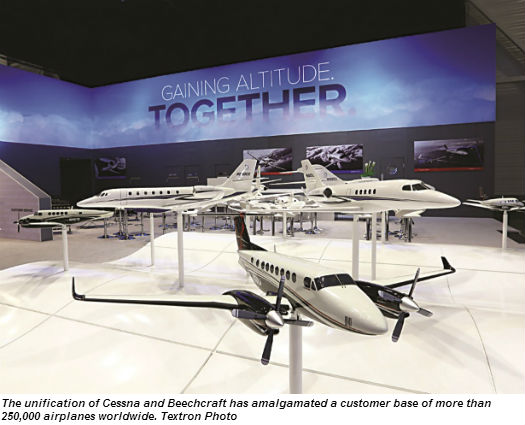Estimated reading time 5 minutes, 54 seconds.
It’s official: Cessna, Beechcraft and Hawker are now under the single umbrella of Textron Aviation. But while Textron is looking forward to increased revenues and cost-savings from its new, unified aviation segment, the company is planning on keeping these three iconic brands distinct “to preserve their rich histories and respective strengths in the marketplace,” according to a Textron Aviation spokesperson.
Textron Inc. announced in March that it had closed its acquisition of Beech Holdings, LLC—the parent of Beechcraft Corporation, which emerged in 2013 as the result of Hawker Beechcraft’s bankruptcy proceedings. Under the terms of the transaction, Textron purchased all outstanding equity interests in Beech Holdings for approximately US$1.4 billion in cash. It then brought together its Cessna business with Beechcraft to form Textron Aviation, a new entity under the leadership of Scott Ernest, who has served as Cessna’s president and CEO since 2011.
The numbers behind the new segment are impressive. The unification of Cessna and Beechcraft has created an installed customer base of more than 250,000 airplanes worldwide, including 9,000 business jets, more than 9,000 turboprops and more than 180,000 piston-engine aircraft. Cessna and Beechcraft together produced about $4.6 billion in revenues during 2013, and Textron estimates that Beechcraft will add about $1.5 billion in revenue to the aviation segment this year. In his first-quarter earnings call on May 1, 2014, Textron CEO Scott Donnelly told investors that he feels “just as good about [the Beechcraft investment] as when we announced it,” predicting that the Beechcraft acquisition will be accretive by $0.25 to $0.30 per share on a fully annualized basis.
Textron is promising benefits for customers, too. “From our customers’ perspective, the formation of Textron Aviation creates a broader selection of aircraft and the largest global service network—all sharing the same high standards of quality and innovation,” a Textron Aviation spokesperson told Skies. The combined Beechcraft, Cessna and Hawker service network includes 23 companyowned service facilities around the globe, and access to more than 40 mobile service units stationed throughout North America and Europe.
Although Textron expects the integration process to continue over the next six to 12 months, Textron Aviation’s sales force is already integrated and selling across both product lines, the spokesperson said. In May, the Beechcraft, Cessna and Hawker brands were unified for the first time publicly when Textron Aviation made a high-profile debut at the European Business Aviation Convention and Exhibition (EBACE) in Geneva. There, the company spotlighted the new Cessna Citation M2 light jet and Citation Sovereign+ midsize jet, both of which entered service in December 2013. But Textron Aviation had a full range of Cessna and Beechcraft aircraft on display in Switzerland, including Cessna’s Grand Caravan EX, Citation CJ4 and Citation XLS+, and Beechcraft’s Baron G58, King Air C90GTx, King Air 250 and Special Mission King Air 350ER.
What does the future hold for Textron Aviation’s product line? In May, aviation analyst Rolland Vincent fuelled speculation when he observed, “With 10 Textron Aviation models priced new at less than $10 million (and four priced between $6.1 to 8.5 million), we would not be surprised to see some consolidation within this new company’s product portfolio.” Vincent suggested that certain low-output product lines—notably the Citation Mustang and CJ2+—could be particularly vulnerable to being taken out of production. But if Textron is considering such a move, it’s not yet admitting to it. When asked about potential consolidation, the Textron Aviation spokesperson told Skies, “There are no plans to discontinue any models currently in production.”
Textron has, however, made it clear that it will not be building new Hawker jets, although it will continue to support existing models—whose owners represent an important source of future customers for Cessna. In his first-quarter earnings call (as recorded by seekingalpha.com), Donnelly told investors, “Obviously we feel good about the fact that we now have a huge install base of Hawker jets and these are customers that are very, very important to us . . . as they move to a new jet we obviously want to see them move into the Citation jet family and we will do everything to make sure they have a very [positive] service experience to help promote that on a go-forward basis.”
Meanwhile, it seems safe to say that the Beechcraft King Air line won’t be going anywhere. “It’s a great product; it’s always been very well received,” Donnelly said in his earnings call. “Customers like it and it’s a workhorse in that industry.” Although King Air deliveries in the first quarter of 2014 were down over 2013, Donnelly attributed that decline to “catch-up deliveries” as Beechcraft emerged from bankruptcy in 2013.
Textron Aviation’s spokesperson confirmed the King Air’s importance to the company, stating, “Continued investment in the King Air product line is a high priority for Textron Aviation. While we are not prepared to discuss specific upgrades today, there are exciting developments in the works as it relates to the performance, reliability and flexibility of the King Air.”

